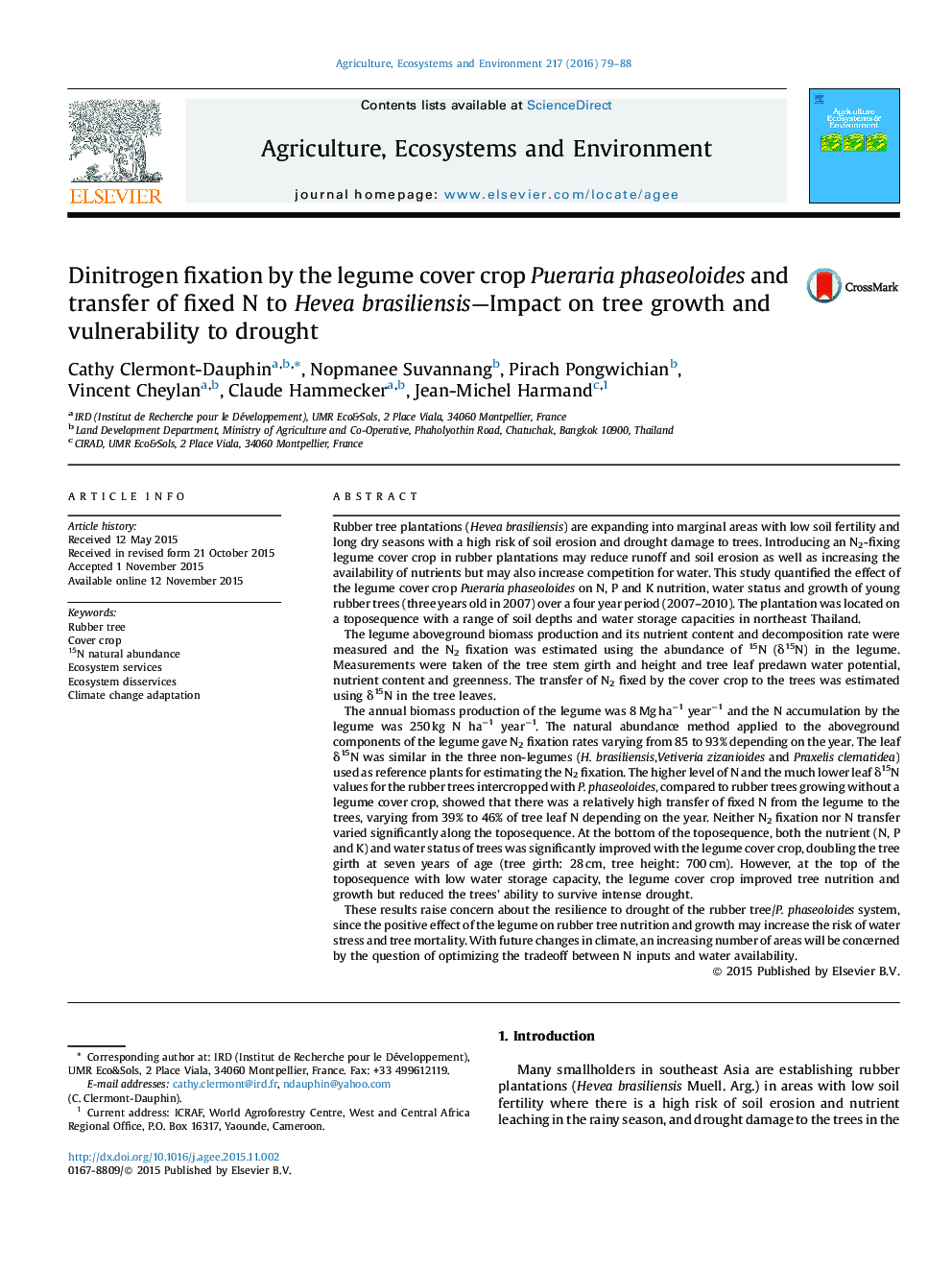| کد مقاله | کد نشریه | سال انتشار | مقاله انگلیسی | نسخه تمام متن |
|---|---|---|---|---|
| 2413673 | 1552035 | 2016 | 10 صفحه PDF | دانلود رایگان |

• On an N depleted soil, 89% of the legume aboveground N was estimated to be derived from N2 fixation.
• Comparison of δ15N values showed that 39–46% of tree leaf N was fixed by the legumes.
• Legumes improved nutrition and increased tree growth when water supply was not limiting.
• Legumes increased tree growth and rubber tree mortality when water supply was limited.
• The nutrient/water availability tradeoff must be optimized for future drier climates.
Rubber tree plantations (Hevea brasiliensis) are expanding into marginal areas with low soil fertility and long dry seasons with a high risk of soil erosion and drought damage to trees. Introducing an N2-fixing legume cover crop in rubber plantations may reduce runoff and soil erosion as well as increasing the availability of nutrients but may also increase competition for water. This study quantified the effect of the legume cover crop Pueraria phaseoloides on N, P and K nutrition, water status and growth of young rubber trees (three years old in 2007) over a four year period (2007–2010). The plantation was located on a toposequence with a range of soil depths and water storage capacities in northeast Thailand.The legume aboveground biomass production and its nutrient content and decomposition rate were measured and the N2 fixation was estimated using the abundance of 15N (δ15N) in the legume. Measurements were taken of the tree stem girth and height and tree leaf predawn water potential, nutrient content and greenness. The transfer of N2 fixed by the cover crop to the trees was estimated using δ15N in the tree leaves.The annual biomass production of the legume was 8 Mg ha−1 year−1 and the N accumulation by the legume was 250 kg N ha−1 year−1. The natural abundance method applied to the aboveground components of the legume gave N2 fixation rates varying from 85 to 93% depending on the year. The leaf δ15N was similar in the three non-legumes (H. brasiliensis, Vetiveria zizanioides and Praxelis clematidea) used as reference plants for estimating the N2 fixation. The higher level of N and the much lower leaf δ15N values for the rubber trees intercropped with P. phaseoloides, compared to rubber trees growing without a legume cover crop, showed that there was a relatively high transfer of fixed N from the legume to the trees, varying from 39% to 46% of tree leaf N depending on the year. Neither N2 fixation nor N transfer varied significantly along the toposequence. At the bottom of the toposequence, both the nutrient (N, P and K) and water status of trees was significantly improved with the legume cover crop, doubling the tree girth at seven years of age (tree girth: 28 cm, tree height: 700 cm). However, at the top of the toposequence with low water storage capacity, the legume cover crop improved tree nutrition and growth but reduced the trees' ability to survive intense drought.These results raise concern about the resilience to drought of the rubber tree/P. phaseoloides system, since the positive effect of the legume on rubber tree nutrition and growth may increase the risk of water stress and tree mortality. With future changes in climate, an increasing number of areas will be concerned by the question of optimizing the tradeoff between N inputs and water availability.
Journal: Agriculture, Ecosystems & Environment - Volume 217, 1 February 2016, Pages 79–88